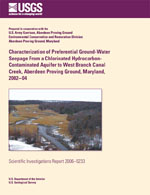Characterization of Preferential Ground-Water Seepage From a Chlorinated Hydrocarbon-Contaminated Aquifer to West Branch Canal Creek, Aberdeen Proving Ground, Maryland, 2002-04
Links
- More information: USGS Index Page (html)
- Download citation as: RIS | Dublin Core
Abstract
Wetlands act as natural transition zones between ground water and surface water, characterized by the complex interdependency of hydrology, chemical and physical properties, and biotic effects. Although field and laboratory demonstrations have shown efficient natural attenuation processes in the non-seep wetland areas and stream bottom sediments of West Branch Canal Creek, chlorinated volatile organic compounds are present in a freshwater tidal creek at Aberdeen Proving Ground, Maryland. Volatile organic compound concentrations in surface water indicate that in some areas of the wetland, preferential flow paths or seeps allow transport of organic compounds from the contaminated sand aquifer to the overlying surface water without undergoing natural attenuation. From 2002 through 2004, the U.S. Geological Survey, in cooperation with the Environmental Conservation and Restoration Division of the U.S. Army Garrison, Aberdeen Proving Ground, characterized preferential ground-water seepage as part of an ongoing investigation of contaminant distribution and natural attenuation processes in wetlands at this site. Seep areas were discrete and spatially consistent during thermal infrared surveys in 2002, 2003, and 2004 throughout West Branch Canal Creek wetlands. In these seep areas, temperature measurements in shallow pore water and sediment more closely resembled those in ground water than those in nearby surface water. Generally, pore water in seep areas contaminated with chlorinated volatile organic compounds had lower methane and greater volatile organic compound concentrations than pore water in non-seep wetland sediments. The volatile organic compounds detected in shallow pore water in seeps were spatially similar to the dominant volatile organic compounds in the underlying Canal Creek aquifer, with both parent and anaerobic daughter compounds detected. Seep locations characterized as focused seeps contained the highest concentrations of chlorinated parent compounds, relatively low concentrations of chlorinated daughter compounds, and insignificant concentrations of methane in shallow pore water samples. These seeps were primarily along the creek edge or formed a dendritic-like pattern between the wetland and creek channel. In contrast, seep locations characterized as diffuse seeps contained relatively high concentrations of chlorinated daughter compounds (or a mixture of daughter and parent compounds) and detectable methane concentrations in shallow pore water samples. These seeps were primarily along the wetland boundary. Qualitative thermal infrared surveys coupled with quantitative verification of temperature differences, and screening for volatile organic compound and methane concentrations proved to be effective tools in determining the overall extent of preferential seepage. Hydrologic and physical properties of wetland sediments were characterized at two focused and one diffuse seep location. In the seeps with focused discharge, measured seepage was consistent over the tidal cycle, whereas more variability with tidal fluctuation was measured in the diffuse seep location. At all locations, areas were identified within the general seep boundaries where discharge was minimal. In all cases, the geometric mean of non-zero vertical flux measurements was greater than those previously reported in the non-seep wetland sediments using flow-net analysis. Flux was greater in the focused discharge areas than in the diffuse discharge area, and all fluxes were within the range reported in the literature for wetland discharge. Vertical hydraulic conductivity estimated from seepage flux and a mean vertical gradient at seeps with focused discharge resulted in a minimum hydraulic conductivity two orders of magnitude greater than those estimated in the non-seep sediment. In contrast, vertical conductivity estimates at a diffuse seep were similar to estimates along a nearby line of section through a non-seep area.
Study Area
| Publication type | Report |
|---|---|
| Publication Subtype | USGS Numbered Series |
| Title | Characterization of Preferential Ground-Water Seepage From a Chlorinated Hydrocarbon-Contaminated Aquifer to West Branch Canal Creek, Aberdeen Proving Ground, Maryland, 2002-04 |
| Series title | Scientific Investigations Report |
| Series number | 2006-5233 |
| DOI | 10.3133/sir20065233 |
| Year Published | 2007 |
| Language | English |
| Publisher | U.S. Geological Survey |
| Contributing office(s) | Maryland-Delaware-District of Columbia Water Science Center |
| Description | viii, 193 p. |
| Time Range Start | 2002-01-01 |
| Time Range End | 2004-12-31 |
| Online Only (Y/N) | Y |


